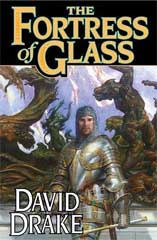The Fortress of GlassBook One of |
|
|
This is a work of fiction. All the characters and events portrayed in this book are fictional, and any resemblance to real people or incidents is purely coincidental. First printing, April 2006 Distributed by Simon & Schuster Printed in the United States of America |
ISBN-13: 978-0-7653-1259-4
|
DEDICATIONTo Mark L. Van Name ACKNOWLEDGMENTSDan Breen continues as my first reader, just as careful and crotchety as ever. He tends toward proper grammar (some might say pleonasm), and I tend toward the striking ellipsis (sometimes more striking than intelligible), so we make a good team. Dorothy Day has been doing continuity checking for me on this on several previous books. That is, I'll need to know the name of (to pick a real example) Katchin the Miller's wife, and she'll tell me that it depends on which book I choose. (I've needed a continuity checker longer than I've had one.) My webmaster, Karen Zimmerman, has a skill at finding data which goes beyond craftsmanship. When I need a reference, it appears magically in my in-box within a couple hours. Mark Van Name has been my friend for more than twenty years, and for that reason I dedicated a book to him back in 1990. Mark is a variety of things besides being my friend, however. Among them, he's a management and marketing consultant; in which capacity he advised me on the structure of The Crown of the Isles, the trilogy of which this novel is part. Computers (two of them) Died in Making This Book. (Yes, I'm used to it by now.) Mark, my son Jonathan, and Jennie Faries got me out of holes. My wife Jo bore with me, fed me superbly, and kept the house as clean as possible under the circumstances. (I'm really going to clean up my mess of paper now.) My thanks to all those above, and to others who just by being nice people made my world brighter than it would've been otherwise. AUTHOR'S NOTEAs before in the Isles series, I've based the magic on that of the Mediterranean Basin in Classical times. The voces mysticae (which I've called words of power) are taken from real spell tablets. Their purpose was to call the attention of demiurges (entities between men and Gods) to the wishes of the person casting the spell. I do not personally believe in Classical magic or any magic, but neither do I choose to pronounce the voces mysticae aloud: I've been wrong before. In my writing I always use bits and pieces not only of history but of other fiction, scenes and phrases that made a strong impression on me. This time the plot was shaped in part by my study of Spawn, a story by P. Schuyler Miller. Those of you who haven't read Spawn can find it reprinted in the fat anthology The World Turned Upside Down, along with many other stories which the three editors found particularly memorable. Another direct influence was Ovid, who can be amazingly evocative with a mere line or two. For an example of what I mean, compare (on my website; see below) my translation of the Perseus section of the Metamorphoses with the portion of Fortress involving Cashel and the Daughter of Phorcys. Again as usual, I've translated scraps from real Latin poets into the fabric of this novel. While it's rarely a good idea to assume that a fictional character is expressing the author's real beliefs, I will note here that Garric's observations on O fons Bandusiae summarize the reasons I carried the OCT edition of Horace with me through my time in the army in 1969-71. There are times and places in which it's very important to have proof that civilization exists, or at least that it once existed. Dave Drake |
|
 The Fortress of Glass is the first in the Crown of the Isles trilogy, which will conclude the epic Lord of the Isles series. A true trilogy, the action extends over the whole three-book arc. The Fortress of Glass begins the story of how the new kingdom of the Isles is finally brought into being by the group of heroes and heroines who have been central to all the books in the series. The group includes Prince Garric, heir to the throne of the Isles, his consort Liane, his sister Sharina, her herculean sweetheart Cashel, his sister Ilna, with her adopted child Merota and piratical Chalcus.
The Fortress of Glass is the first in the Crown of the Isles trilogy, which will conclude the epic Lord of the Isles series. A true trilogy, the action extends over the whole three-book arc. The Fortress of Glass begins the story of how the new kingdom of the Isles is finally brought into being by the group of heroes and heroines who have been central to all the books in the series. The group includes Prince Garric, heir to the throne of the Isles, his consort Liane, his sister Sharina, her herculean sweetheart Cashel, his sister Ilna, with her adopted child Merota and piratical Chalcus.